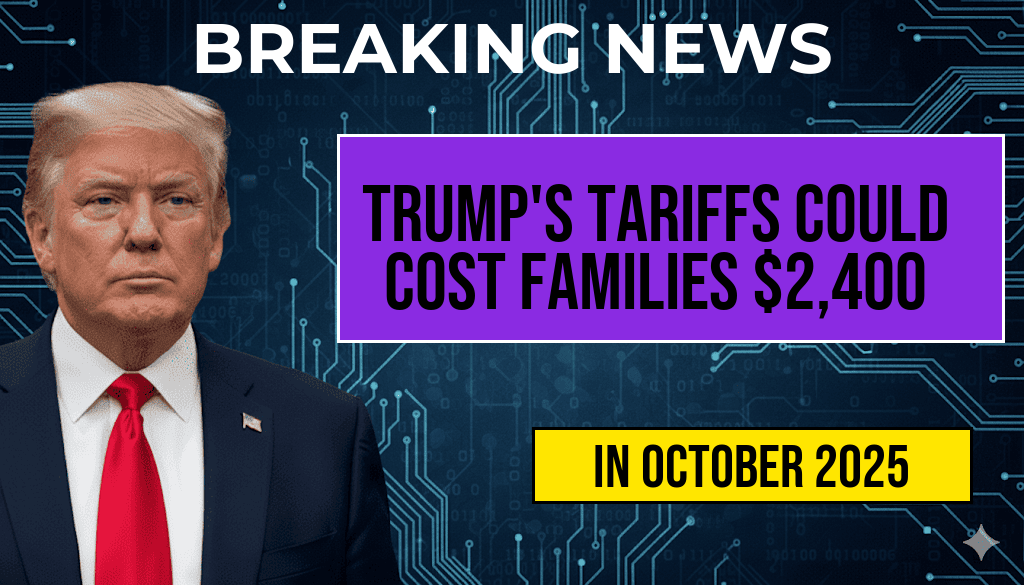Recent analyses indicate that the tariffs implemented during Donald Trump’s presidency may impose an annual financial burden of approximately $2,400 on American families. This so-called “Turbulence Tax” stems from increased costs on imported goods, particularly in sectors such as electronics, clothing, and food. As the U.S. grapples with inflation and supply chain disruptions, understanding the implications of these tariffs has become more crucial than ever for households across the nation. This article delves into the economic factors at play, examining how these tariffs affect consumer prices and assessing the broader impact on family budgets.
Understanding Trump’s Tariffs
During his term, former President Trump initiated several tariffs, particularly aimed at China, to protect American industries and encourage domestic manufacturing. These tariffs were part of a broader trade strategy designed to reduce the trade deficit and revive U.S. manufacturing. However, the consequences of these tariffs have led to rising prices for many consumer goods.
The Cost of Tariffs on Families
According to a study conducted by the Peterson Institute for International Economics, the average American family has incurred an additional cost of around $2,400 annually due to these tariffs. This figure is derived from a combination of higher prices on imported goods and the cascading effects on the economy.
Key Sectors Affected
- Electronics: Tariffs on imported electronics have led to notable price increases, affecting everything from smartphones to laptops.
- Clothing: The apparel industry has faced significant challenges, with tariffs causing cost hikes that retailers often pass on to consumers.
- Food Products: Imported food items, including certain fruits and vegetables, have seen price surges, impacting grocery bills.
The Broader Economic Impact
While the intention behind the tariffs was to bolster American manufacturing, the reality has been more complex. The increase in consumer prices has strained family budgets and contributed to inflationary pressures in the economy. The U.S. Bureau of Labor Statistics reported that inflation rates reached 5.4% in 2021, with many attributing part of this rise to tariff-related price increases.
Examining Inflation Rates
| Year | Inflation Rate (%) |
|---|---|
| 2018 | 2.4 |
| 2019 | 1.8 |
| 2020 | 1.2 |
| 2021 | 5.4 |
| 2022 | 7.0 |
Consumer Sentiment and Future Implications
Consumer sentiment has been affected as families adjust to these increased costs. A survey by the University of Michigan revealed that many Americans are increasingly concerned about their financial stability. As the economic landscape continues to evolve, the long-term effects of these tariffs remain uncertain.
Looking Ahead
As discussions about trade policy continue, the impact of Trump’s tariffs serves as a reminder of the complexities involved in international trade. Policymakers must navigate these challenges carefully to balance the interests of domestic manufacturers with the need to protect consumers from rising costs. The potential for future tariffs or changes in trade agreements could further influence American families’ financial health.
In light of these developments, families are encouraged to stay informed about changes in trade policy and their potential effects on everyday expenses. Understanding the economic landscape can help households better prepare for fluctuations in consumer prices and make informed decisions about their budgets.
Frequently Asked Questions
What are Trump’s tariffs and how do they impact families?
Trump’s tariffs are taxes imposed on imported goods, which can lead to increased prices for consumers. This can particularly affect families as the costs of everyday items rise, potentially resulting in an annual burden of $2,400 per household.
What is the ‘Turbulence Tax’ mentioned in the article?
The ‘Turbulence Tax’ refers to the economic instability and higher costs that families may face as a result of tariffs. It highlights the financial strain that can arise from fluctuating prices on imported products.
How do tariffs affect the prices of imported goods?
Tariffs increase the cost of imported goods, which can lead manufacturers and retailers to raise prices. This ultimately means that consumers pay more for items that rely on international supply chains.
Can families expect to see immediate effects from these tariffs?
Yes, families may begin to experience immediate effects from tariffs as prices for consumer products rise in response to increased import costs. This can lead to higher expenses for essential items.
What can families do to mitigate the impact of these tariffs?
Families can mitigate the impact of tariffs by seeking alternatives, such as purchasing domestically produced goods, comparing prices, and budgeting more effectively to accommodate the increased costs.

Leave a Reply